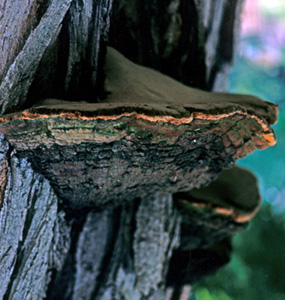Phellinus rimosus

Image Courtesy of Emily Johnson
| Click to Enlarge |
| Click For Image Gallery |
|
Group of Fungi: Polypores Family: Hymenochaetaceae Latin Name: Phellinus rimosus (Berk.) Pilát. Synonym(s): Fomes rimosus (Berk.) Cooke Common Name: Cracked-cap Polypore Description: Semicircular, shelf-like or (more commonly) hoof-shaped structure; cap 2–12 in (5–30 cm) across and 3/4–2 in (2–5 cm) thick, upper surface brown, reddish brown to brownish black, with concentric furrows, becoming cracked, finely hairy, tough and woody; margin of cap rounded; spore-bearing surface yellow-brown to dark brown, pores very small and difficult to see; spores pale brown in mass. Biological Role: Pathogen of living trees but also can be considered as a decomposer of wood when present on dead trees. Habitat: On living and dead black locust trees; solitary or several fruiting bodies occurring together. Geographical Distribution: Widely distributed throughout eastern North America wherever black locust occurs. Comments: Because it is restricted to black locust trees, Phellinus rimosus is a very easy fungus to identify. The fruiting bodies are exceedingly hard and literally could be used in lieu of a hammer to drive a nail into wood! |
| Go Back |